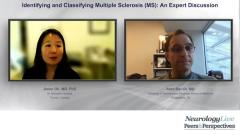
Identifying and Classifying Multiple Sclerosis (MS): An Expert Discussion
Experts discuss the challenges of detecting progression in multiple sclerosis (MS), addressing the lack of available assessment tools but the importance of patient-reported signs and symptoms.
Episodes in this series

Transcript
Jiwon Oh, MD, PhD: Going back to the clinical aspect, can I ask you, I mean, what does smouldering MS look like in an individual patient? Like, why don't we, maybe your clinic this week, what would you expect to see in somebody that you think has smouldering MS?
Amit Bar-Or, MD: So smouldering MS can manifest with gradual worsening in multiple different domains. One, for instance, is cognitive function. People can just get, over time, less and less able to deal with multitasking, with planning, with organizations, some memory and word finding issues. And that can kind of creep up gradually. There can be issues with gradually worsening ability to walk because of weakness or stiffness in the legs or issues with balance. Fatigue is often something that can creep and affect people. And so many of the same symptoms that can be impacted through a relapse may also manifest as part of smouldering. And what I try to do is, for instance, ask patients questions such as, “Can you think of something that you were able to do a year ago that you're not able to do as well now?” And they may say, “Oh, you know, my thinking, I can't do quite as well. My memory, my walking, bowel, bladder, and sexual dysfunction,” are things that can also be involved in smouldering worsening of MS.
Jiwon Oh, MD, PhD: And thanks for that really nice description of what sort of questions you actually use to draw out these symptoms in patients. But can I ask you, you mentioned that it sounds like smouldering MS manifests in many different ways in patients. And in some people, it may be fatigue. In some people, it may be more cognitive deficits. And in some people, it may be other forms of physical disability. But in addition to the questions that you ask, are there specific tests that you use in the clinic that you find particularly useful? And it's OK to say that you don't have any.
Amit Bar-Or, MD: Yeah, so I must say I don't think that we're very good at systematically doing this in a way that we can really quantify and base discussions and decisions on that. Although things that one can do, for instance, of course, the 25-foot walk, is one aspect that is relatively easy to do in the clinic on regular visits. The SDMT [Symbol Digit Modalities Test] is one of the cognitive tests that is relatively easy to administer and has been studied quite well and is useful in ways to track people's cognitive status. So, there are tools that people can use. A challenge that we all have in busy clinics is how to do that, how to do it systematically and consistently in a way that is actually meaningful. And what I mentioned earlier, which is the potential application of additional ways of capturing people not just during their visits, but between their visits, with, for instance, digital tools and so on, may add an important layer to our ability to gauge the smouldering process that's happening slowly over time.
Jiwon Oh, MD, PhD: I agree with you. It's there's many different tools that you can use, but, you know, time is always something that's tight in a short follow-up visit where, you know, when people living with MS, we're…I think, trying to assess many, many different things. And that includes, obviously, speaking to the patient about their symptoms, trying to screen for whether patients have had relapses, then also reviewing their MRI results, then, you know, talking to them about medications and side effects, and then safety monitoring. And so, you know, I think the audience is mainly clinicians, so we all understand how difficult it is to include some of these additional tools. But I think you've mentioned some really helpful, relatively easy to administer tools, including the 25-foot timed walk, the Symbol Digit Modalities Test, which is a test of information processing speed. And, like you said, useful and pretty quick to administer for potentially monitoring, but there's issues like practice effect that we need to take into account, of course. And then there's a whole range of different patient-reported outcome measures that can assess some of these more difficult-to-quantify symptoms, like fatigue and quality of life. But, I think, and you've kind of touched on this, one of the issues as a clinician is not only time, but also knowing amongst all of the different scales that are available, which one is the one that we should use, and what is a clinically actionable threshold, and all of these things. But all this to say, I think it's pretty clear that it's not that easy to detect changes related to smouldering MS with our traditional neurological exam, and there are a wide spectrum of tools available. We just need to, as a field, figure out how to most efficiently use them in the clinic. And, specifically, which questionnaires or scales to use and what's the clinically relevant point at which point you think that there is some sort of action that a clinician needs to take based on a result.
Amit Bar-Or, MD: Absolutely, Jiwon, agree completely. And one of the things that could contribute to doing this efficiently is recognizing that it may not be sort of one-size-fits- all. In other words, it’s not necessary and certainly not practical to do all of these on all patients. But if you can identify a domain [in] which a given person seems to be getting worse, this is then something to tailor. And you may say that for this person, I'm going to follow the SDMT, and that's going to be more informative than doing the 25-time walk or vice versa.
Jiwon Oh, MD, PhD: I also just wanted to loop back to another point that you made earlier. I think the questions that you generally asked, the open-ended questions to your patients are probably, at least at the current time, one of the best tools that we have to detect smouldering MS, where you say, is there something this year that you've noticed that you can't do as well as you did the year before? And so, I think when you don't have a perfect tool and you may not even necessarily have a perfect toolbox, asking open-ended questions like that are really the best way to gauge how a patient in front of you is doing. And similar to what you do, over time, you end up developing relationships with patients and know what their interests are and what their hobbies are. And so I'll often ask questions like, when I know one of my patients is say a runner, I'll ask if they can still run as far as they did the year before, or someone who's a hiker, or someone who is an avid chess player, for instance, I'll ask questions relevant to you know, things that people do regularly so that they have this internal gauge of what may be changing that we, as their clinician, who, you know, as you said earlier, we're only often seeing them once every 6 to 12 months, may not necessarily be able to pick up on.
Transcript is AI-generated and edited for clarity and readability.
Newsletter
Keep your finger on the pulse of neurology—subscribe to NeurologyLive for expert interviews, new data, and breakthrough treatment updates.


































